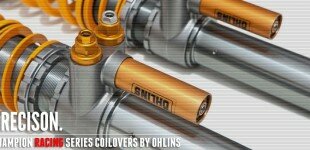Featured Posts
Porsche 911 GT3 R Hybrid 2.0
By: Michael Harley
Autoblog.com
Spinning at 36,000 revolutions per minute just two feet from my right thigh, a 31-pound flywheel is screaming like a five-horsepower Shop-Vac with the filter removed. The sound pierces the composite shell of my racing helmet and drills through my form-fitted foam earplugs before painfully slamming into my eardrums.
Yet despite the aching annoyance, I welcome and embrace the high-pitched drone. It means, in the simplest terms, that the monster inside this ballistic carbon fiber cocoon is not only awake, but completely energized.
With a stab of the throttle, the kinetic energy in the spinning flywheel is automatically exchanged for electricity – the charged ions power two strong electric motors on the front axle. Instantaneously bestowed with 200 torque-laden horsepower, the sticky Michelin slicks claw at the pavement with a vengeance. I clench the wheel as the carbon-fiber bodied race car lunges forward with more accelerative force than an F-16 fighter jet at takeoff power.
Welcome to the driver’s seat of the Porsche 911 GT3 R Hybrid 2.0.
Peer high up on Porsche’s performance ladder, above the two-dozen or so street legal 911 models – above even the GT2 – to find the automaker’s most competitive cars. Vehicles bred purposely for the track.
The Porsche 997 GT3 R Hybrid 2.0 is one such model. Compared to its predecessor, which debuted last year, the second-generation hybrid is 20 percent lighter and more efficient without any concession to lap times. While sharing the same paint scheme, the new vehicle is easily identified by its lack of intakes in front of each rear wheel – changes to engine cooling allowed the slats to be dropped and aerodynamic efficiency improved.
Beneath the orange, white, silver and black wrap, the GT3 R Hybrid 2.0 features a monocoque body of hot-galvanized steel with a welded roll cage. Body panels are carbon fiber and there are lightweight polycarbonate windows on all sides, including the front windshield. At each corner is a height-adjustable suspension with dual coil springs and Sachs gas-pressure fixed-position dampers. The steering rack is power-assisted, with an electro-hydraulic pressure feed, and there is a car-mounted air-jack system for use in the pits.
With help from Bosch MS 4.0 engine management and a race exhaust system, the gas engine is tuned to develop 470 horsepower.
At the front are six-piston monobloc aluminum calipers over 15-inch ventilated iron rotors. The rear features four-piston monobloc aluminum calipers over 14-inch ventilated iron rotors and there are optimized brake ducts aimed at all four to ensure sufficient cooling. Compared to the standard GT3 Cup (which we drove earlier this year), the wheel/tire package on the GT3 R Hybrid is wider to accommodate the extra workload of the tires. The front and rear wheels are one-piece Rays forged aluminum alloy (11.5×18 and 13×18, respectively) with a single central-locking nut, while dry compound Michelin Porsche Cup N1 slicks tires come standard (30/65-18 front and 31/71-18 rear).
Hung behind the rear wheels of the 997 GT3 R Hybrid is a very traditional race-bred gasoline-consuming flat six-cylinder engine. Displacing 4.0-liters, the naturally aspirated four-valve powerplant features multi-point fuel injection and dry sump lubrication. With help from Bosch MS 4.0 engine management and a race exhaust system, the gas engine is tuned to develop 470 horsepower. The standard transmission is a six-speed sequential dog-type gearbox. There is an aluminum clutch pedal on the floor (controlling the triple-plate carbon clutch), but no transmission lever to the right of the driver. Instead, shifting is accomplished via small aluminum paddles on the backside of the steering wheel. A mechanically-locking rear axle differential completes the rear-mounted driveline.
Things become very interesting at this point – the GT3 R Hybrid has a completely independent second driveline in the front of the chassis.
Located just to the right of the driver, where a passenger seat would normally be situated, is a large charcoal gray carbon fiber case. At first glance it appears to be a fuel cell, yet the ominous bright yellow “high voltage” warning sticker and large air ducts feeding cool atmospheric air tell a different story. Porsche engineers reveal that a 31-pound composite flywheel, mounted horizontally on oil-cooled ceramic bearings, is buried deep inside. It is called a flywheel accumulator.
A flywheel is a rotating mechanical device used to store energy. Unlike nearly every hybrid gasoline-electric vehicle on the market today, which require batteries or capacitors to store electricity, the GT3 R Hybrid uses a spinning flywheel mounted on an electric motor/generator. It’s a brilliant solution, as a vacuum-encased flywheel unit is not only lighter than a battery pack but is capable of being fully “charged” (accelerated to its maximum speed) and “discharged” (decelerated to a near stop) multiple times a minute without adverse affects – batteries and capacitors would quickly overheat rendering them nearly useless after a short period of such abuse.
With a curb weight of just 2,866 pounds and a total system power of 672 horsepower, the all-wheel-drive Porsche GT3 R Hybrid 2.0 will accelerate to 60 mph in about 2.5 seconds. Its top speed is gearing limited to about 175 mph.
The GT3 R Hybrid 2.0 is absolutely spectacular, yet Porsche is still chasing perfection.
Source: Autoblog.com
Leave a Reply
You must be logged in to post a comment.






















